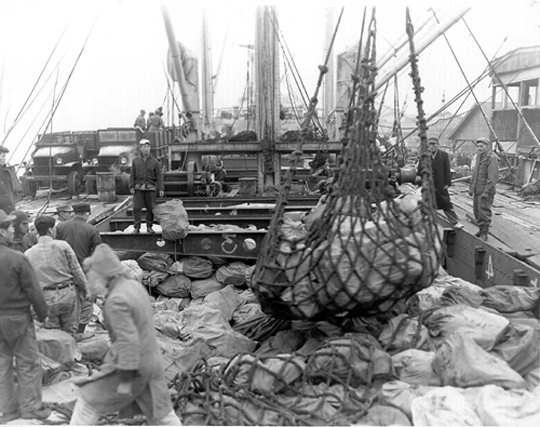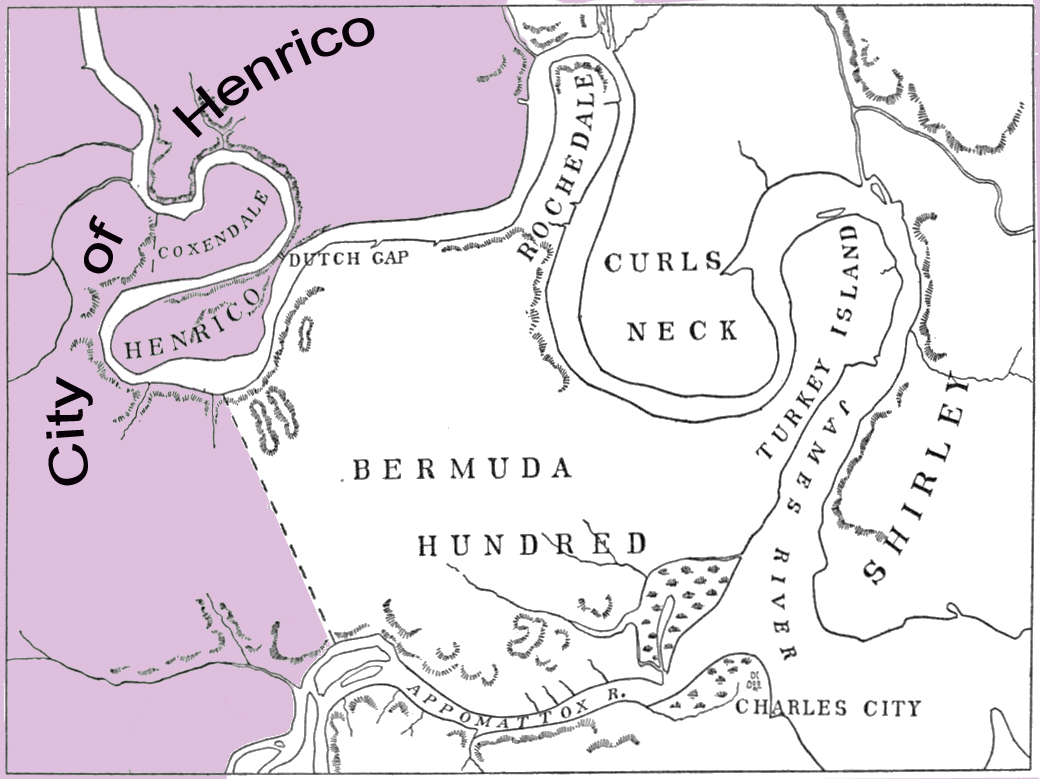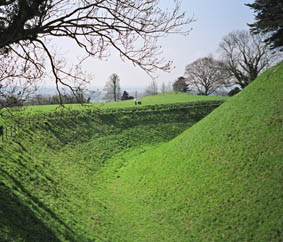|
Dutch Gap Canal
Dutch Gap Canal is located on the James River in Chesterfield County, Virginia just north of the lost 17th-century town of Henricus. The canal's construction was initiated by Union forces during the American Civil War to bypass a meander loop of the river around a peninsula known as Farrar's Island that was controlled by Confederate artillery. The canal was completed after the war and is now the main channel of the James River in this area. Today, the area south of the canal is the location of the Dutch Gap Conservation Area and Henricus Historical Park. Origin of Name The Dutch Gap Canal was named for its location at Dutch Gap, which was formerly a neck of land that joined Farrar's Island to the mainland. The James River around Farrar's Island, from Drewry's Bluff to the confluence of the Appomattox River below Bermuda Hundred, originally had a number of meandering loops. The Dutch Gap was the isthmus between the narrowest of these loops. Here, the James River on the west bank ... [...More Info...] [...Related Items...] OR: [Wikipedia] [Google] [Baidu] |
Container Ship
A container ship (also called boxship or spelled containership) is a cargo ship that carries all of its load in truck-size intermodal containers, in a technique called containerization. Container ships are a common means of commercial intermodal freight transport and now carry most seagoing non-bulk cargo. Container ship capacity is measured in twenty-foot equivalent units (TEU). Typical loads are a mix of 20-foot (1-TEU) and 40-foot (2-TEU) ISO-standard containers, with the latter predominant. Today, about 90% of non-bulk cargo worldwide is transported by container ships, and the largest modern container ships can carry up to 24,000 TEU (e.g., '' Ever Ace''). Container ships now rival crude oil tankers and bulk carriers as the largest commercial seaborne vessels. History There are two main types of dry cargo: bulk cargo and break bulk cargo. Bulk cargoes, like grain or coal, are transported unpackaged in the hull of the ship, generally in large volume. Break-bulk car ... [...More Info...] [...Related Items...] OR: [Wikipedia] [Google] [Baidu] |
Isthmus
An isthmus (; ; ) is a narrow piece of land connecting two larger areas across an expanse of water by which they are otherwise separated. A tombolo is an isthmus that consists of a spit or bar, and a strait is the sea counterpart of an isthmus. Isthmus vs land bridge vs peninsula ''Isthmus'' and ''land bridge'' are related terms, with isthmus having a broader meaning. A land bridge is an isthmus connecting Earth's major landmasses. The term ''land bridge'' is usually used in biogeology to describe land connections that used to exist between continents at various times and were important for migration of people and various species of animals and plants, e.g. Beringia and Doggerland. An isthmus is a land connection between two bigger landmasses, while a peninsula is rather a land protrusion which is connected to a bigger landmass on one side only and surrounded by water on all other sides. Technically, an isthmus can have canals running from coast to coast (e.g. the Panama ... [...More Info...] [...Related Items...] OR: [Wikipedia] [Google] [Baidu] |
Union Army
During the American Civil War, the Union Army, also known as the Federal Army and the Northern Army, referring to the United States Army, was the land force that fought to preserve the Union (American Civil War), Union of the collective U.S. state, states. It proved essential to the preservation of the United States as a working, viable republic. The Union Army was made up of the permanent Regular Army (United States), regular army of the United States, but further fortified, augmented, and strengthened by the many temporary units of dedicated United States Volunteers, volunteers, as well as including those who were drafted in to service as Conscription in the United States, conscripts. To this end, the Union Army fought and ultimately triumphed over the efforts of the Confederate States Army in the American Civil War. Over the course of the war, 2,128,948 men enlisted in the Union Army, including 178,895 United States Colored Troops, colored troops; 25% of the white men who s ... [...More Info...] [...Related Items...] OR: [Wikipedia] [Google] [Baidu] |
Benjamin Butler (politician)
Benjamin Franklin Butler (November 5, 1818 – January 11, 1893) was an American major general of the Union Army, politician, lawyer, and businessman from Massachusetts. Born in New Hampshire and raised in Lowell, Massachusetts, Butler is best known as a political major general of the Union Army during the American Civil War and for his leadership role in the impeachment of U.S. President Andrew Johnson. He was a colorful and often controversial figure on the national stage and on the Massachusetts political scene, serving five terms in the U.S. House of Representatives and running several campaigns for governor before his election to that office in 1882. Butler, a successful trial lawyer, served in the Massachusetts legislature as an antiwar Democrat and as an officer in the state militia. Early in the Civil War he joined the Union Army, where he was noted for his lack of military skill and his controversial command of New Orleans, which brought him wide dislike in the South ... [...More Info...] [...Related Items...] OR: [Wikipedia] [Google] [Baidu] |
A Columbiad Overlooking Farrar's Island Near The Dutch Gap Canal
A, or a, is the first Letter (alphabet), letter and the first vowel of the Latin alphabet, Latin alphabet, used in the English alphabet, modern English alphabet, the alphabets of other western European languages and others worldwide. Its name in English is English alphabet#Letter names, ''a'' (pronounced ), plural English alphabet#Letter names, ''aes''. It is similar in shape to the Greek alphabet#History, Ancient Greek letter alpha, from which it derives. The Letter case, uppercase version consists of the two slanting sides of a triangle, crossed in the middle by a horizontal bar. The lowercase version can be written in two forms: the double-storey a and single-storey ɑ. The latter is commonly used in handwriting and fonts based on it, especially fonts intended to be read by children, and is also found in italic type. In English grammar, "English articles, a", and its variant "English articles#Indefinite article, an", are Article (grammar)#Indefinite article, indefinite arti ... [...More Info...] [...Related Items...] OR: [Wikipedia] [Google] [Baidu] |
William Farrar (settler)
William Farrar (April 1583 – ) was a landowner and politician in Colony of Virginia, colonial Virginia. He was a subscriber to the third charter of the Virginia Company who immigrated to the colony from Kingdom of England, England in 1618. After surviving the Indian massacre of 1622, Jamestown massacre of 1622, he moved to Jordan Point, Virginia, Jordan's Journey. In the following year, Farrar became involved in North America's first breach of promise suit when he proposed to Cecily Jordan Farrar, Cecily Jordan. In 1626, Farrar was appointed to the Virginia Governor's Council, Council of Virginia where he served as an advisor to the royal governor, a judge of the highest court in the colony, and a member of the Virginia General Assembly of Colonial Jamestown. He was also appointed magistrate of the upper James River community. In both these roles, he served as a voice of the early planters' interest as the colony transitioned from being managed by the Virginia Company and bec ... [...More Info...] [...Related Items...] OR: [Wikipedia] [Google] [Baidu] |
Magistrate
The term magistrate is used in a variety of systems of governments and laws to refer to a civilian officer who administers the law. In ancient Rome, a '' magistratus'' was one of the highest ranking government officers, and possessed both judicial and executive powers. In other parts of the world, such as China, a magistrate was responsible for administration over a particular geographic area. Today, in some jurisdictions, a magistrate is a judicial officer who hears cases in a lower court, and typically deals with more minor or preliminary matters. In other jurisdictions (e.g., England and Wales), magistrates are typically trained volunteers appointed to deal with criminal and civil matters in their local areas. Original meaning In ancient Rome, the word '' magistratus'' referred to one of the highest offices of state. Analogous offices in the local authorities, such as ''municipium'', were subordinate only to the legislature of which they generally were members, '' ex officio'' ... [...More Info...] [...Related Items...] OR: [Wikipedia] [Google] [Baidu] |
Virginia Governor's Council
The Governor's Council (also known as the "Council of State" or simply "the Council") was the upper house of the colonial legislature (the House of Burgesses was the other house) in the Colony of Virginia from 1607 until the American Revolution in 1776. Consisting of 12 men who, after the 1630s were appointed by the British Sovereign, the Governor's Council also served as an advisory body to the Virginia Royal Governor and as the highest judicial body in the colony. Organization The Council consisted of no more than 12 men who served lifetime appointments to advise the governor and were, together with the governor, the highest court in the colony. Thus this body served as a legislative, executive, and judicial body. Modeled after the British House of Lords, the Governor's Council went through a definite evolution as the Virginia colony grew. During much of the colonial period, the governor was absentee and the lieutenant governor was the beneficiary of the council's advice. When ... [...More Info...] [...Related Items...] OR: [Wikipedia] [Google] [Baidu] |
City Of Henrico (Virginia Company)
The City of Henrico (also known as Henrico) is one of the oldest counties in the Colony of Virginia. It was one of four incorporations established in the colony by its proprietor, the Virginia Company. The City of Henrico, which included the settlement of Henricus, was the furthest incorporation upstream on the James River. In 1634, Henrico was reorganized under royal authority as the shire of Henrico, one of eight shires in the Crown Colony of Virginia, Later, it became known as Henrico County, Virginia. History The City of Henrico was formed in 1618 when the Virginia Company, the proprietor of the colony of Virginia, provided instructions to Governor Sir George Yeardley for the reorganization of the colony's government. These instructions provided for the incorporation of most of the plantations and developments of Virginia into four boroughs or cities that extended across the James River, the main conduit of transportation of the era. These incorporations were called James Ci ... [...More Info...] [...Related Items...] OR: [Wikipedia] [Google] [Baidu] |
Dutch Republic
The United Provinces of the Netherlands, also known as the (Seven) United Provinces, officially as the Republic of the Seven United Netherlands (Dutch: ''Republiek der Zeven Verenigde Nederlanden''), and commonly referred to in historiography as the Dutch Republic, was a federal republic that existed from 1579, during the Dutch Revolt, to 1795 (the Batavian Revolution). It was a predecessor state of the Netherlands and the first fully independent Dutch nation state. The republic was established after seven Dutch provinces in the Spanish Netherlands revolted against rule by Spain. The provinces formed a mutual alliance against Spain in 1579 (the Union of Utrecht) and declared their independence in 1581 (the Act of Abjuration). It comprised Groningen, Frisia, Overijssel, Guelders, Utrecht, Holland and Zeeland. Although the state was small and contained only around 1.5 million inhabitants, it controlled a worldwide network of seafaring trade routes. Through its tradin ... [...More Info...] [...Related Items...] OR: [Wikipedia] [Google] [Baidu] |
Ditch (fortification)
In military engineering, a ditch is an obstacle designed to slow down or break up an attacking force, while a trench is intended to provide cover to the defenders. In military fortifications the side of a ditch farthest from the enemy and closest to the next line of defence is known as the scarp while the side of a ditch closest to the enemy is known as the counterscarp. Uses In early fortifications, ditches were often used in combination with ramparts to slow down the enemy whilst defensive fire could be brought to bear from the relative protection afforded by the rampart and possibly the palisade. In medieval fortification, a ditch was often constructed in front of a defensive wall to hinder mining and escalade activities from an attacker. When filled with water, such a defensive ditch is called a moat. However, moats may also be dry. Later star forts designed by military engineers like Vauban, comprised elaborate networks of ditches and parapets, carefully calculated ... [...More Info...] [...Related Items...] OR: [Wikipedia] [Google] [Baidu] |
Thomas Dale
Sir Thomas Dale ( 1570 − 19 August 1619) was an English naval commander and deputy-governor of the Virginia Colony in 1611 and from 1614 to 1616. Governor Dale is best remembered for the energy and the extreme rigour of his administration in Virginia, which established order and in various ways seems to have benefited the colony, although he was criticised for high-handedness. He is also credited with the establishment of Bermuda Hundred, Virginia, Bermuda Hundred, City Point, Virginia, Bermuda Cittie, and the Cittie of Henricus. Biography Early career From about 1588 to 1609, Thomas Dale was in the service of the Low Countries (the Netherlands and parts of modern Belgium) with the English army originally under Robert Dudley, 1st Earl of Leicester, Robert Dudley, Earl of Leicester. Because of his ability and ambition, he became friends with many people in positions of authority. In 1599 Thomas Dale was recruited by the Earl of Essex for England's army, and was knighted by Jam ... [...More Info...] [...Related Items...] OR: [Wikipedia] [Google] [Baidu] |







